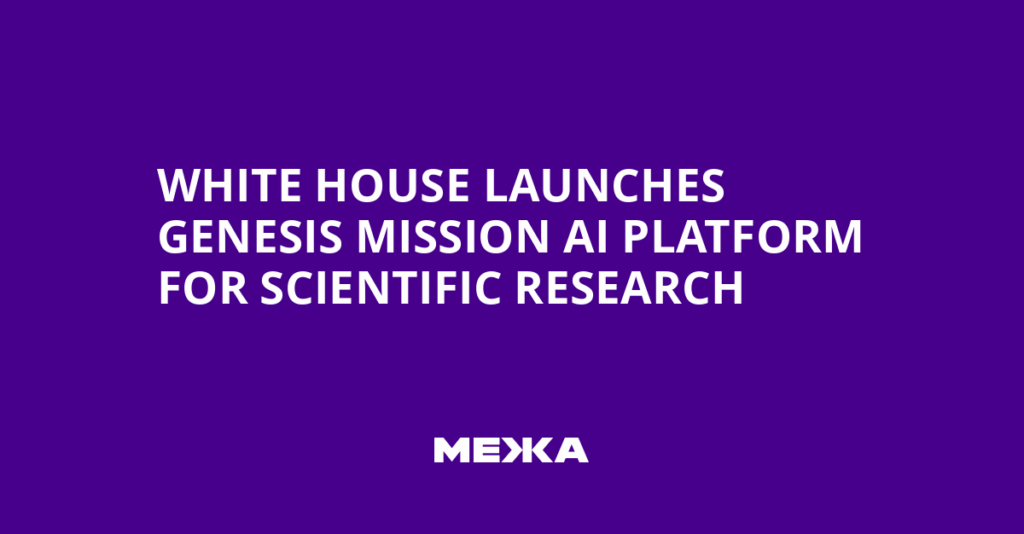The White House’s eyes are on artificial intelligence again. President Donald Trump approved a sweeping new program that binds Big Tech, academia, and federal science labs into one AI-powered research entity. The goal is simple: accelerate scientific breakthroughs while keeping the US in front of global competitors like China. The program arrives at a moment when AI’s energy demands are skyrocketing, tech firms are expanding their research footprints, and policymakers are arguing over how fast to move.
The new effort sits under the Genesis Mission, an initiative that taps America’s national laboratories to train and operate scientific AI models. The directive signals Trump’s intent to strengthen national security through faster discovery, larger datasets, and greater collaboration across public and private sectors. It poses questions about energy strain, regulatory control, and long-term strategy as AI development intensifies across every sector.
What’s Happening & Why This Matters
A New National AI Platform
The Genesis Mission creates a shared AI platform run through the US Department of Energy (DoE). The system draws on decades of scientific datasets from labs such as Argonne, Ames, and Berkeley. These labs unlock access to information across physics, chemistry, biotech, quantum science, semiconductors, materials, and nuclear energy.
DoE Secretary Chris Wright says the mission is AI’s focus from “business and consumer services” to scientific discovery. He explains: “The private sector has launched artificial intelligence at huge scale… what we’re doing here is pivoting those efforts to focus on scientific discovery, engineering advancements.”
The platform connects government researchers with partners from OpenAI, Nvidia, Oracle, and universities. It supports direct cooperation across federal research agencies. The White House frames the mission as essential for staying “ahead in the AI race.”

Partnerships Already in Motion
Companies now work side-by-side with the DoE on supercomputing, model training, and energy-related AI tools.
Nvidia and Oracle are building AI-optimized supercomputers for Argonne. Dell develops new high-performance systems for Berkeley Lab. Google continues to advance domain-specific health-care AI.
The Genesis Mission accelerates this momentum through shared systems and faster data access.
But the plan arrives as AI’s energy appetite grows. The DoE estimates US data centers may consume up to 12% of national electricity by 2028, a jump from roughly 4% in 2023. Wright claims the mission intends to “reverse price rises that have infuriated American citizens” by improving grid efficiency. The promise is bold. The grid is old. AI demand escalates faster than new infrastructure comes online.
AI Advancement and Geopolitics
Trump sees AI as a strategic lever in the global competition with China. The US now takes ownership stakes in major chip companies, including a 10% position in Intel, and secures revenue-linked agreements with AMD and Nvidia to maintain export access to China.
At the same time, Trump pushes to prevent states from imposing their own AI regulations. He argues that state-level rules slow innovation and weaken national strength. But lawmakers and digital safety groups warn of the risks after reports connecting unregulated AI systems to self-harm and mental-health concerns. The tension shapes every discussion moving forward.
The Genesis Mission follows a market trend: AI development is too large for strict government-only or industry-only control. The US pursues cross-sector partnerships not only for discovery but for economic and geopolitical leverage.
TF Summary: What’s Next
The Genesis Mission pushes the United States deeper into an AI-driven scientific era. The project strengthens ties between government labs and tech giants while feeding long-term national priorities. But every benefit comes with a rising cost, especially as electricity consumption surges. The pressure on America’s power grid and regulatory framework persists even as AI advances accelerate.
MY FORECAST: Expect the White House to expand this model into broader AI-enabled infrastructure programs through 2025 and 2026. Trump’s administration treats AI as a national advantage, not a tool for one industry. More partnerships with chipmakers, cloud providers, and universities are coming. The grid will struggle, the debates will intensify, and the arms race with China will force US policymakers to move faster than they prefer.
— Text-to-Speech (TTS) provided by gspeech


